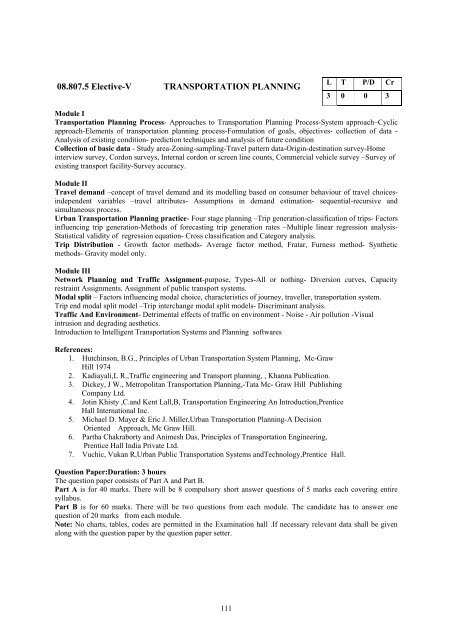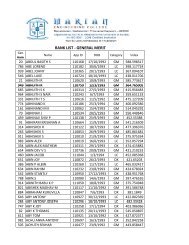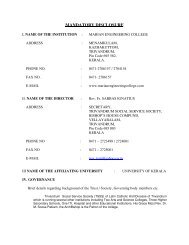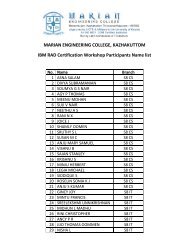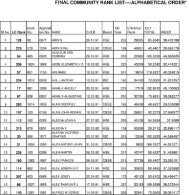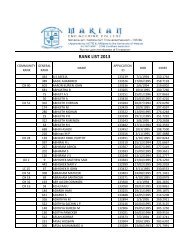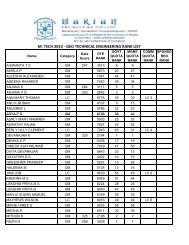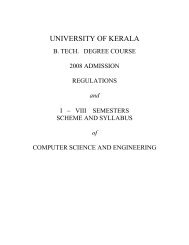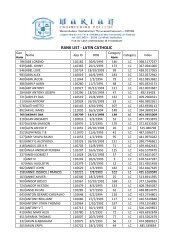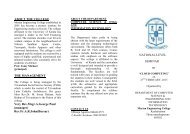UNIVERSITY OF KERALA - College of Engineering, Trivandrum
UNIVERSITY OF KERALA - College of Engineering, Trivandrum
UNIVERSITY OF KERALA - College of Engineering, Trivandrum
Create successful ePaper yourself
Turn your PDF publications into a flip-book with our unique Google optimized e-Paper software.
08.807.5 Elective-V TRANSPORTATION PLANNING<br />
L T P/D Cr<br />
3 0 0 3<br />
Module I<br />
Transportation Planning Process- Approaches to Transportation Planning Process-System approach–Cyclic<br />
approach-Elements <strong>of</strong> transportation planning process-Formulation <strong>of</strong> goals, objectives- collection <strong>of</strong> data -<br />
Analysis <strong>of</strong> existing condition- prediction techniques and analysis <strong>of</strong> future condition<br />
Collection <strong>of</strong> basic data - Study area-Zoning-sampling-Travel pattern data-Origin-destination survey-Home<br />
interview survey, Cordon surveys, Internal cordon or screen line counts, Commercial vehicle survey –Survey <strong>of</strong><br />
existing transport facility-Survey accuracy.<br />
Module II<br />
Travel demand –concept <strong>of</strong> travel demand and its modelling based on consumer behaviour <strong>of</strong> travel choicesindependent<br />
variables –travel attributes- Assumptions in demand estimation- sequential-recursive and<br />
simultaneous process.<br />
Urban Transportation Planning practice- Four stage planning –Trip generation-classification <strong>of</strong> trips- Factors<br />
influencing trip generation-Methods <strong>of</strong> forecasting trip generation rates –Multiple linear regression analysis-<br />
Statistical validity <strong>of</strong> regression equation- Cross classification and Category analysis.<br />
Trip Distribution - Growth factor methods- Average factor method, Fratar, Furness method- Synthetic<br />
methods- Gravity model only.<br />
Module III<br />
Network Planning and Traffic Assignment-purpose, Types-All or nothing- Diversion curves, Capacity<br />
restraint Assignments. Assignment <strong>of</strong> public transport systems.<br />
Modal split – Factors influencing modal choice, characteristics <strong>of</strong> journey, traveller, transportation system.<br />
Trip end modal split model –Trip interchange modal split models- Discriminant analysis.<br />
Traffic And Environment- Detrimental effects <strong>of</strong> traffic on environment - Noise - Air pollution -Visual<br />
intrusion and degrading aesthetics.<br />
Introduction to Intelligent Transportation Systems and Planning s<strong>of</strong>twares<br />
References:<br />
1. Hutchinson, B.G., Principles <strong>of</strong> Urban Transportation System Planning, Mc-Graw<br />
Hill 1974<br />
2. Kadiayali,L R.,Traffic engineering and Transport planning, , Khanna Publication.<br />
3. Dickey, J W., Metropolitan Transportation Planning,-Tata Mc- Graw Hill Publishing<br />
Company Ltd.<br />
4. Jotin Khisty ,C.and Kent Lall,B, Transportation <strong>Engineering</strong> An Introduction,Prentice<br />
Hall International Inc.<br />
5. Michael D. Mayer & Eric J. Miller,Urban Transportation Planning-A Decision<br />
Oriented Approach, Mc Graw Hill.<br />
6. Partha Chakraborty and Animesh Das, Principles <strong>of</strong> Transportation <strong>Engineering</strong>,<br />
Prentice Hall India Private Ltd.<br />
7. Vuchic, Vukan R,Urban Public Transportation Systems andTechnology,Prentice Hall.<br />
Question Paper:Duration: 3 hours<br />
The question paper consists <strong>of</strong> Part A and Part B.<br />
Part A is for 40 marks. There will be 8 compulsory short answer questions <strong>of</strong> 5 marks each covering entire<br />
syllabus.<br />
Part B is for 60 marks. There will be two questions from each module. The candidate has to answer one<br />
question <strong>of</strong> 20 marks from each module.<br />
Note: No charts, tables, codes are permitted in the Examination hall .If necessary relevant data shall be given<br />
along with the question paper by the question paper setter.<br />
111


